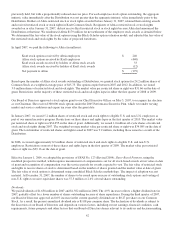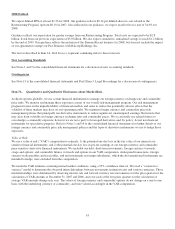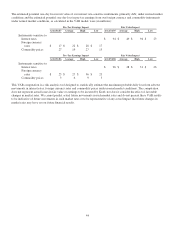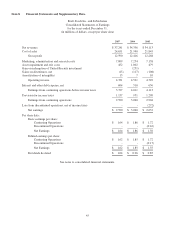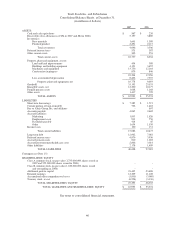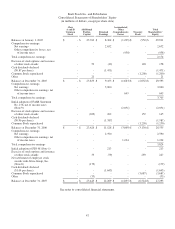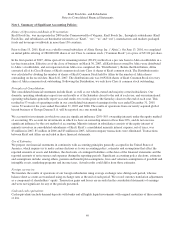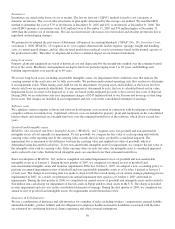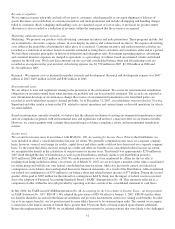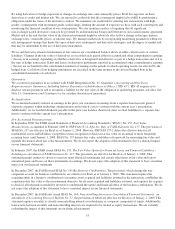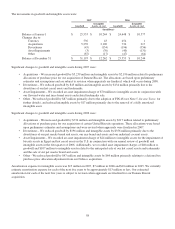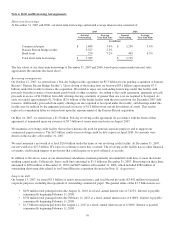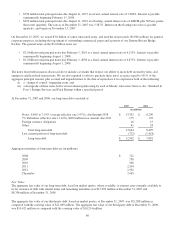Kraft 2007 Annual Report Download - page 66
Download and view the complete annual report
Please find page 66 of the 2007 Kraft annual report below. You can navigate through the pages in the report by either clicking on the pages listed below, or by using the keyword search tool below to find specific information within the annual report.Revenue recognition:
We recognize revenues when title and risk of loss pass to customers, which generally occurs upon shipment or delivery of
goods. Revenues are recorded net of consumer incentives and trade promotions and include all shipping and handling charges
billed to customers. Kraft’s shipping and handling costs are classified as part of cost of sales. A provision for product return
allowances is also recorded as a reduction of revenues within the same period that the revenue is recognized.
Marketing, administration and research costs:
Marketing - We promote our products with advertising, consumer incentives and trade promotions. These programs include, but
are not limited to, discounts, coupons, rebates, in-store display incentives and volume-based incentives. We expense advertising
costs either in the period the advertising first takes place or as incurred. Consumer incentive and trade promotion activities are
recorded as a reduction of revenues based on amounts estimated as being due to customers and consumers at the end of a period.
We base these estimates principally on historical utilization and redemption rates. For interim reporting purposes, advertising
and consumer incentive expenses are charged to operations as a percentage of volume, based on estimated volume and related
expense for the full year. We do not defer amounts on our year-end consolidated balance sheet and all marketing costs are
recorded as an expense in the year incurred. Advertising expense was $1,554 million in 2007, $1,396 million in 2006 and
$1,314 million in 2005.
Research - We expense costs as incurred for product research and development. Research and development expense was $447
million in 2007, $419 million in 2006 and $385 million in 2005.
Environmental costs:
We are subject to laws and regulations relating to the protection of the environment. We accrue for environmental remediation
obligations on an undiscounted basis when amounts are probable and can be reasonably estimated. The accruals are adjusted as
new information develops or circumstances change. Recoveries of environmental remediation costs from third parties are
recorded as assets when their receipt is deemed probable. As of December 31, 2007, our subsidiaries were involved in 70 active
Superfund and other similar actions in the U.S. related to current operations and certain former or divested operations for which
we retain liability.
Based on information currently available, we believe that the ultimate resolution of existing environmental remediation actions
and our compliance in general with environmental laws and regulations will not have a material effect on our financial results.
However, we cannot quantify with certainty the potential impact of future compliance efforts and environmental remediation
actions.
Income taxes:
We account for income taxes in accordance with SFAS No. 109, Accounting for Income Taxes. Prior to the Distribution, we
were included in Altria’s consolidated federal income tax return. We generally computed income taxes on a separate company
basis; however, some of our foreign tax credits, capital losses and other credits could not have been used on a separate company
basis. To the extent that Altria used our foreign tax credits and other tax benefits in its consolidated federal income tax return,
we recognized the benefit in the calculation of our provision for income taxes. This benefit was approximately $270 million in
2007 (both through the date of Distribution as well as post-Distribution carryback claims to pre-Distribution periods),
$195 million in 2006 and $225 million in 2005. We made payments to, or were reimbursed by, Altria for the tax effects
resulting from being included in Altria’s tax return. As of March 31, 2007, we are no longer a member of the Altria consolidated
tax return group and will file our own federal consolidated income tax return. Altria also previously carried our federal tax
contingencies on its balance sheet and reported them in its financial statements. As a result of the Distribution, Altria transferred
our federal tax contingencies of $375 million to our balance sheet and related interest income of $77 million. During the second
quarter, Altria paid us $305 million for the federal tax contingencies held by them, less the impact of federal reserves reversed
due to the adoption of Financial Accounting Standards Board (“FASB”) Interpretation No. 48. This amount is reflected as a
component of other within the net cash provided by operating activities section of the consolidated statement of cash flows.
In July 2006, the FASB issued FASB Interpretation No. 48, Accounting for the Uncertainty in Income Taxes - an interpretation
of FASB Statement No. 109 (“FIN 48”). We adopted the provisions of FIN 48 effective January 1, 2007. FIN 48 clarifies when
tax benefits should be recorded in the financial statements and provides measurement criteria for valuing such benefits. In order
for us to recognize benefits, our tax position must be more likely than not to be sustained upon audit. The amount we recognize
is measured as the largest amount of benefit that is greater than 50 percent likely of being realized upon ultimate settlement.
Before the implementation of FIN 48, we established additional provisions for certain positions that were likely to be challenged
51



